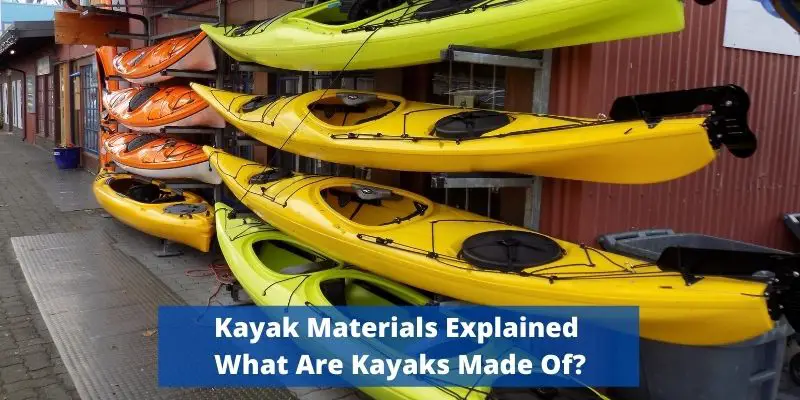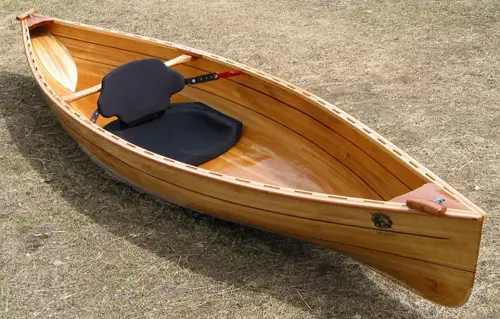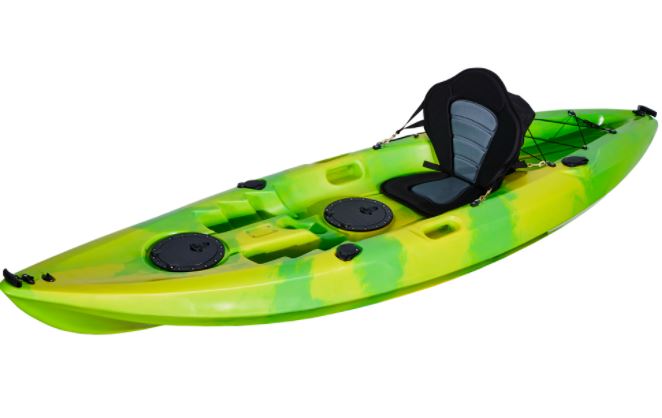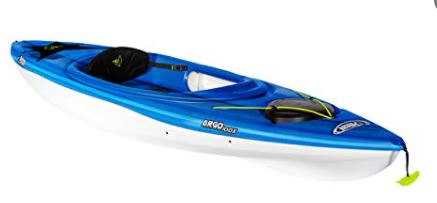Kayak manufacturers use different materials to construct them which can have an impact on how a kayak performs as well its overall quality rating by paddlers. There are many different types of materials that can make up a kayak. Understanding the advantages and disadvantages of each type will help you decide on which construction best suits your needs.
So what are different kayak materials? In this blog, the different types of materials used to construct hard-shell kayaks will be discussed. We’ll also cover different manufacturing processes and how those are applied in the construction of these kayaks for added durability.

Different Types Of Kayak Materials Used In Kayak Construction
Wooden Kayaks

Wooden kayaks are made with two main construction styles
- Strip-built or cold-molded wooden kayaks – It’s made by binding strips together with glue and wood dowels using temporary frames, then adding nails for extra strength. The best part is it allows for many design possibilities.
- Stitch-and-glue method – You will need to cut the wood into desired shapes and stitch them together. You must then glue everything so that the design is fully intact.
Once the frame is assembled, it’s coated with defensive layers of fiberglass and resin to protect against weathering. Then a varnish finish protects its natural beauty so you can enjoy this piece for years without worrying about warping or water damage.
Wood is not only beautiful but also lightweight and durable. The endless design options make it easy to create a custom kayak that will meet your needs perfectly, at an affordable price point.
Pros
- They have a natural appeal that sets them apart from other boats or canoes on the lake at first glance.
- They are robust as the composite ones with lightweight properties and efficient in structure.
- Build your own kayak and take it for a spin with the freedom to design.
- It will cost you pretty less.
Cons
- The project takes time and woodworking skills to complete one oneself.
- Buying a wooden made will cost you more.
- It is not the best choice for whitewater.
- There are no two wooden boats alike because they come from different craftsmen with unique styles that cannot be recreated by machines
Composite Kayaks

A composite kayak is a high-tech hybrid that combines the best features of each material. For example, there’s fiberglass for durability, aramid for resistance to abrasion or puncture from rock. Then you have carbon fiber reinforced with layers upon layers laminated together.
Fiberglass kayaks are a popular choice for people who like to enjoy the water recreationally. They’re up to 20% lighter than polyethylene boats and have other advantages, too.
The fabrication method starts with the layered fabric which is bonded by resin. The cores are then inserted for rigidity. These base layers become part of a gel coating before finally going through vacuum sealings as well. The kayak’s deck and hull are made separately before fusing them using fiberglass tape, epoxy resin, or a combination of both.
Plastic yaks are adorable, but when it comes to good looks they don’t stand a chance next to composite kayaks.
Composite kayaks are lightweight, fast, and responsive. It has stiffer materials which improve its performance over plastic ones for better tracking.
Pros
- Designed with an excellent strength-to-weight ratio, composite kayaks are ultra-lightweight as well.
- The stiffness of composite materials makes for an improved ride and handling in comparison to other types.
- Composite kayaks offer unmatched performance by combining both speed as well as tracking capabilities into one product.
- It rarely gets damaged by UV rays.
- Repairing small scratches, cracks and punctures are possible with the right tools.
- The use of composite material in sea kayaks and touring kayaks is not new, but it’s becoming more popular.
Cons
- Composite is the most expensive material for hard-shell kayaks.
- Kayak can get damaged when experiencing hard hits with sharp rocks.
Rotomolded Polyethylene

Polyethylene is the most commonly used material for kayaks, but there’s a new kid on the block. Rotomolded polyethylene has been incredibly popular in recent years after Perception kayaks introduced it for the first in the 1970s. It can’t absorb water like other plastics and will not crack or melt when exposed to high temperatures – unlike regular old ones that you surely remember from your childhood.
The process of molding these plastic yaks is called “rotational molding.”
Rotomolded kayaks are made by pouring plastic pellets into a mold, heating them up, and then rotating in an oven-like device called “the rotary pot. The process is repeated until there is an even distribution of melted polyethylene in the mold. The end result is a one-piece kayak that can be launched easily without worrying.
Rotomolded PE kayaks are a low-cost, easy-to-mold plastic that can be customized with colors and patterns.
The so-called “Tupperware” kayaks are typically more affordable and impact-resistant than their alternative, fiberglass counterparts. Polyethylene plastic hulls have some flexibility to them which means they’re more likely to bend but not break on contact with water like in a hard hat situation.
In addition to being an excellent choice for whitewater and rocky terrain, the extra weight of these boats makes them less suitable for speed and long tours.
Pros
- Impact resistant because of their flexible nature
- Good for whitewater and rocky waters
- If you’re looking for an affordable, yet durable kayak that won’t break the bank then look no further than PE hard-shells
Cons
- Heavier
- UV exposure can damage the material – hence extra coatings are needed
- Oil caning can happen
Thermoform Material

You can rate thermoform kayaks somewhere between the PE and composite ones.
It’s surprising to know that thermoformed kayaks have been around for over 50 years. These kayaks use higher-quality plastic and last much longer than their rotomolded counterparts without compromising on weight or durability. Yet they are as light as a composite kayak.
If you’re in the market for a mid-range kayak, thermoform ABS is your best bet. It’s less expensive than polyethylene but cheaper than a composite construction.
Thermoforming is a process that uses heated plastic sheets to create custom shapes. The first step in this series involves fusing multiple layers of material together, with impact-resistant ABS as the base and one or more acrylic coatings on top. These pieces are heated up before being stretched over existing molds using a vacuum.
Thermoforming will require less material for creating finer edges and more intricate designs that would otherwise require a molding machine.
You get a higher level of detail in both the deck and hull, with each being thermoformed separately before being joined together at the shoreline by adhesive or tape depending on preference.
Pros
- More durable and scratch resistant than PE kayaks
- Lightweight as composite ones yet cheaper
- Better UV resistance and shiny outlook
- Can be repaired easily
Cons
- Thermoform ABS
- Over time, even with proper care it’s material will degrade.
- Can be recycled
Inflatable Kayaks
Inflatable kayaks are often used as an alternative to their traditional counterparts. They offer the convenience of portability, but with less durability and lower performance potential in rough water conditions.
The material used to make inflatable kayaks is rubber-like and softer. Their unique design allows them to withstand high inflation pressures, making it possible for the user to deflate and fold their boat when not in use – something that you cannot do with hardshell kayaks.
Don’t know what inflatable kayaks are made of? Well, the following are the three most commonly used materials.
- Polyvinyl Chloride (PVC) – PVC, or polyvinyl chloride is a popular kayak material. It’s inexpensive and can be bonded with other materials for improved strength and durability that also make up the inflatable of your choice. However this polymer does damage easily so you should avoid UV rays as well as high temperatures in order to keep it looking like new.
- Nitrylon – Recently, manufacturers have started to look into more eco-friendly material for inflatable kayaks than PVC. One such alternative is Nitrylon which is a 1200 denier polyester fabric synthetic product that has shown much better durability and puncture resistance than its counterpart from years ago; however it also comes at the cost of being heavier so you’ll find this material on side panels or bottom area.
- Hypalon – The most advanced kayak material is known to be the synthetic rubber patented by DuPont. This high-performance, ruggedized substance has proven itself in extreme conditions like UV radiation, mildew or abrasion and temperature range that can damage other materials, which makes it perfect for outdoor enthusiasts. But the average price of hypalon kayaks is higher than the other two mentioned above.
Check: Best Inflatable Kayaks
Pros
- Lightweight, portable and budget friendly
- Easy to repair with puncture kits
- Can be folded after deflating
Cons
- PVC isn’t good for environment
- Can get punctured
- Folding kayaks can get mold and mildew
- High temperatures and direct sun exposure can cause damage
A Quick Comparison Of Commonly Used Kayak Materials
Thermoformed Vs Rotomolded Kayaks
Thermoform and rotomolded kayaks are both plastic in nature. However, there’s an important difference in the manufacturing process that impacts how they’re designed as well their durability, weight, and performance levels.
The most common and least expensive hard-shell model, the Rotomolded Kayak is great for those who want to have a durable boat with a little weight penalty – making this type ideal for budget-conscious paddlers.
These thermoformed ABS vessels weigh a bit less than composite ones while being just as durable against wear-and-tear caused by exposure outdoors; making them an excellent choice (since this type costs less).
The most popular material for kayaks is thermoformed and it’s easy to see why. However, the answer you will get from people who go into more detail about their choice of kayaks depends on what they want out of one.
Plastic Vs Composite Kayaks
The debate of “Is fiberglass kayak better than plastic for beginners?” never ends. There are those who say that the difference in construction quality, kayak material, and performance between the two types isn’t enough to justify their prices- but what do you think?
A plastic kayak is a preferred choice for novice paddlers because they are much easier on your wallet and is impact resistant. Most sit-on-top or recreational ‘yaks on today’s market use rotomolded polyethylene.
The lightweight and highly efficient design of composite kayaks makes it a great choice for freedom lovers. They’re also exceptionally hard to beat when you need an all-around playboat, with their easy maneuverability as well as sleek looks.
But unless you’re a pro with lots of experience and want to take on long-distance tours, don’t spend thousands on composite kayaks. Why risk when you are not able to reap their full potential?
If you’re not an experienced or frequent traveler, stick with plastic.
What Is The Best Material For Kayak?
What is the best kayak material for your next adventure? There are many different types of materials, each with its own pros and cons. You have to think about what will make – or break – your experience in the water.
For me, the best way to get started is with a rotomolded polyethylene kayak. This lightweight and durable material means that I can take my board everywhere without worrying. What’s more, it only costs you a few hundred dollars.
How much do you want to spend? What type of kayak is right for your needs and wants, the environment in which it will be used (i.e., freshwater vs saltwater), where can I take this boat? These are just some things that might help start off any decision-making process.

Hi, I’m Randy R. Lios and the owner of Floating Kayaks. I’ve always been adventuresome at heart. From the time, I got my first kayak at age 18 until now when I have multiple kayaks with accessories and spend 5-6 hours researching all the new related stuff in the market. I have always been fond of fishing since my childhood and kayaking is part of my weekend routine.
